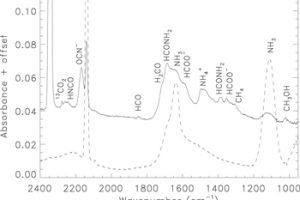Radiation and abundances of organic compounds in planets-forming disks. The study: “X-Ray Photo-desorption of H2O:CO:NH3 Circumstellar Ice Analogs: Gas-phase Enrichment” of A. Jiménez-Escobar (Inaf-OAPA) published in ApJ

From the large number of exoplanets discovered by missions such as Kepler and CoRoT, it is clear that the presence of planets is a common feature in stars of our Galaxy. In particular, it has been estimated that on average each low mass star has one planet. Planets formation is thus an ubiquitous phenomenon across the Milky Way. It is not clear, however, if the evolution of protoplanetary disks, which are the disk-like structures observed in young stars and that may evolve in planetary systems, can be affected by the surrounding environment and/or the radiation of the central star.
In particular, it is important to understand whether X-ray and UV radiation incident on dust grains in protoplanetary disks can induce the formation of organic compounds. These disks, in fact, host a rich population of dust grains, which coagulate with the time in aggregates and then planetesimals. This is the fundamental process in planets formation. Given the low temperature in protoplanetary disks, largely below -200 C, layers of water (H2O) and carbon monoxide (CO) ice deposit on the surface of dust grains. Incident UV and X-ray photons can photo-desorpt the compounds from the ice layer, enriching the planets-forming environment of such organic compounds which are fundamental for the development of life.
This process is the subject of the study: “X-Ray Photo-desorption of H2O:CO:NH3 Circumstellar Ice Analogs: Gas-phase Enrichment” of A. Jiménez-Escobar (Inaf-OAPA), recently published on “the Astrophysical Journal”.The research is based on experiments carried out in the Interstellar Photo-process System of the National Synchrotron Radiation Research Center in Hsinchu (Taiwan), an ultrahigh vacuum chamber of base pressure 1.3 × 10−10 mbar. During the experiment, an ice mixture of H2O+CO+NH3 at a temperature of -260 C has been irradiated for 12 minutes by X-rays. The spectrum of the ice mixtures observed before and after the incidence of the X-ray photons has been compared, revealing an important desorption of organic compounds. The authors of this study have also measured the desorption yield due to X-rays, observing that it is between 2 and 40 times larger than that due to incident UV photons, despite the fact that the former typically decrease faster than the latter with the time. In the contest of planetary formation, then, the desorption of organic compounds from dust grains due to the incidence of X-ray and UV photons, emitted by the central star of by nearby stars, is important for the chemical evolution of the forming planetary system.
The figure (link) shows the spectrum of the ice mixture observed before and after the experiment.
by Mario Giuseppe Guarcello ( follow mguarce)
